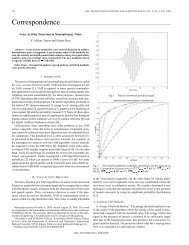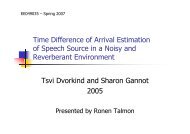Thesis (PDF) - Signal & Image Processing Lab
Thesis (PDF) - Signal & Image Processing Lab
Thesis (PDF) - Signal & Image Processing Lab
Create successful ePaper yourself
Turn your PDF publications into a flip-book with our unique Google optimized e-Paper software.
5.2. IMAGE PROCESSING ON TREE SEMILATTICES 69<br />
exists, and, even though it is not well defined for all complete inf-semilattice elements,<br />
it is always well-defined for elements that are mapped by the erosion, and γ = δε.<br />
In the case of the above tree-representation flat erosion, the adjoint dilation is<br />
given by:<br />
δ(T ) = (t, �t {Mb|b ∈ B}) . (5.9)<br />
5.2 <strong>Image</strong> <strong>Processing</strong> on Tree Semilattices<br />
5.2.1 Proposed Approach<br />
Our goal is to process a given grayscale image f, which we assume to be an integer-<br />
valued function on E, i.e., f ∈ Fun(E, Z). We propose the following approach for<br />
processing f, using the complete inf-semilattice of tree representations.<br />
1. Transform f into a pair (T, ℓ), where T = (t, M) ∈ T L<br />
r is a tree representation,<br />
and ℓ : L ↦→ Z is a function that maps labels into graylevels,<br />
2. Perform one or more morphological operations on T to obtain a processed tree<br />
representation ˆ T = (t, ˆ M).<br />
3. Transform ( ˆ T , ℓ) back into a new image ˆ f ∈ Fun(E, Z), using:<br />
� �<br />
ˆf(x) = ℓ ˆM(x) . (5.10)<br />
Notice that the format for the inverse transform (item 3) is fixed, and does not<br />
depend on the exact definition of the tree transform τ. The user however has a great<br />
deal of freedom for choosing τ itself. A number of tree transforms are discussed<br />
in sections 2.2 and in section 6.1. Because there are many possible alternatives for<br />
defining τ, designing the forward transform is the main issue for applied research in<br />
that field, where the goal is to find the best tree representation of an image in some<br />
sense. In this chapter, however, this issue is not addressed; instead, a tree transform<br />
is assumed given, and we focus on the corresponding morphological operators and<br />
the methodology to obtain them.
















